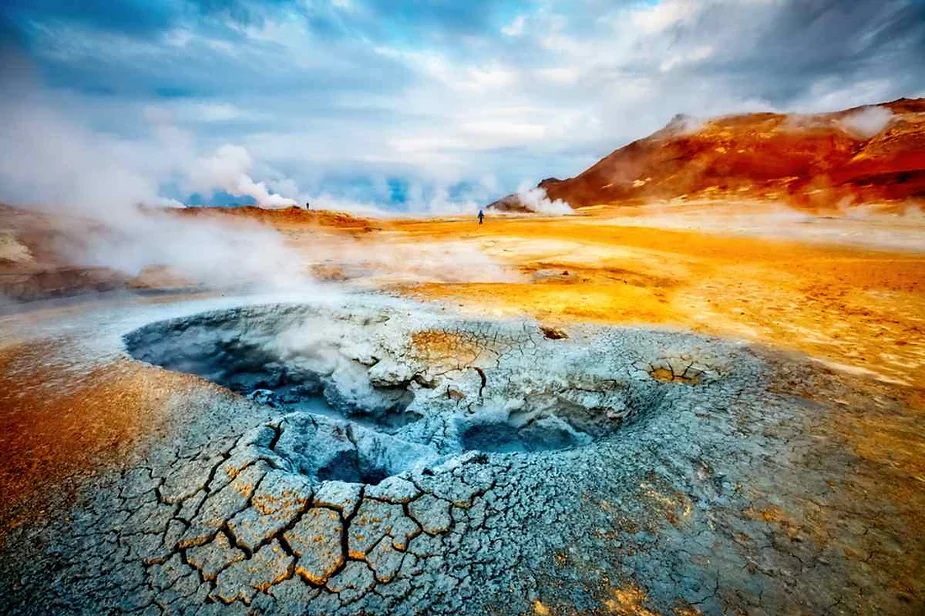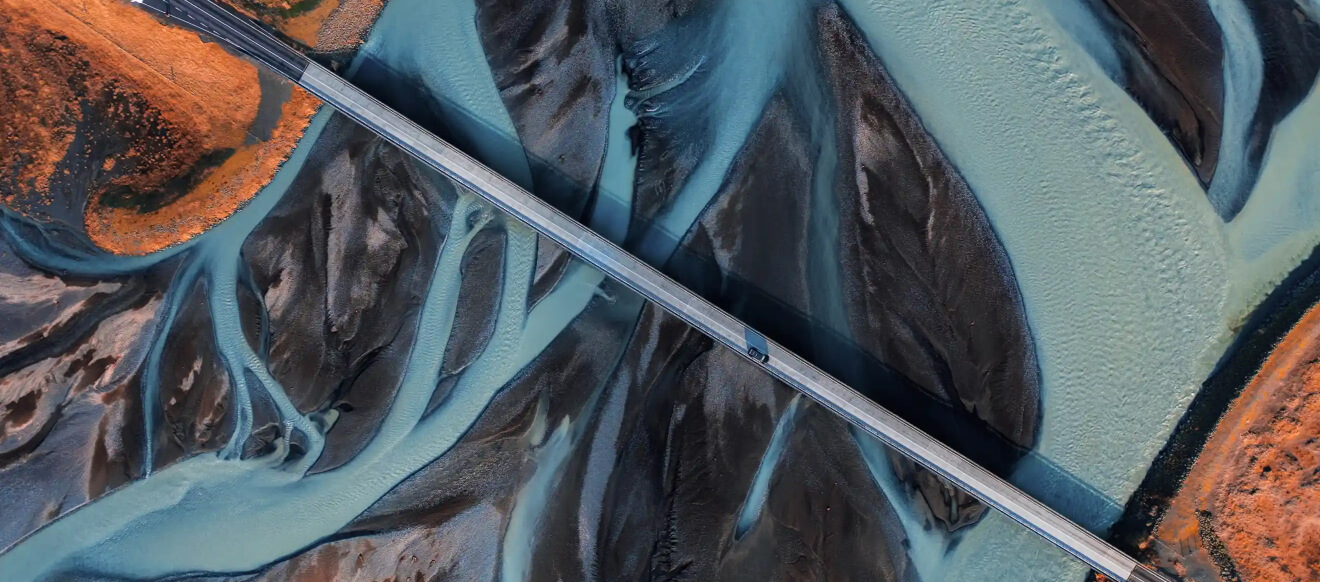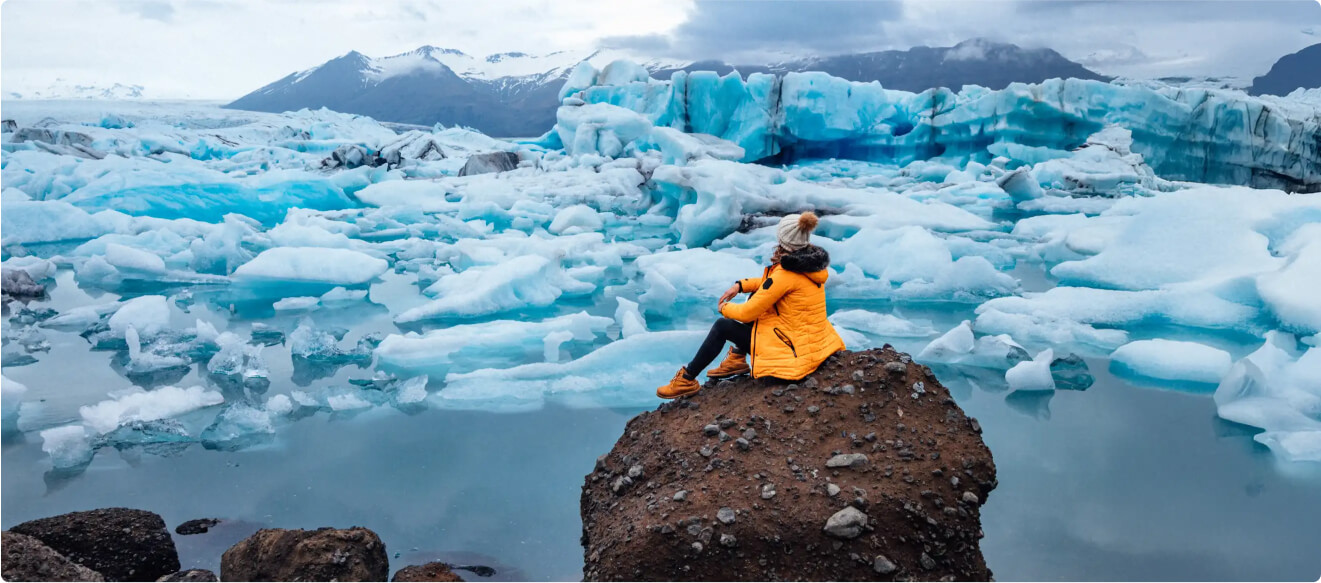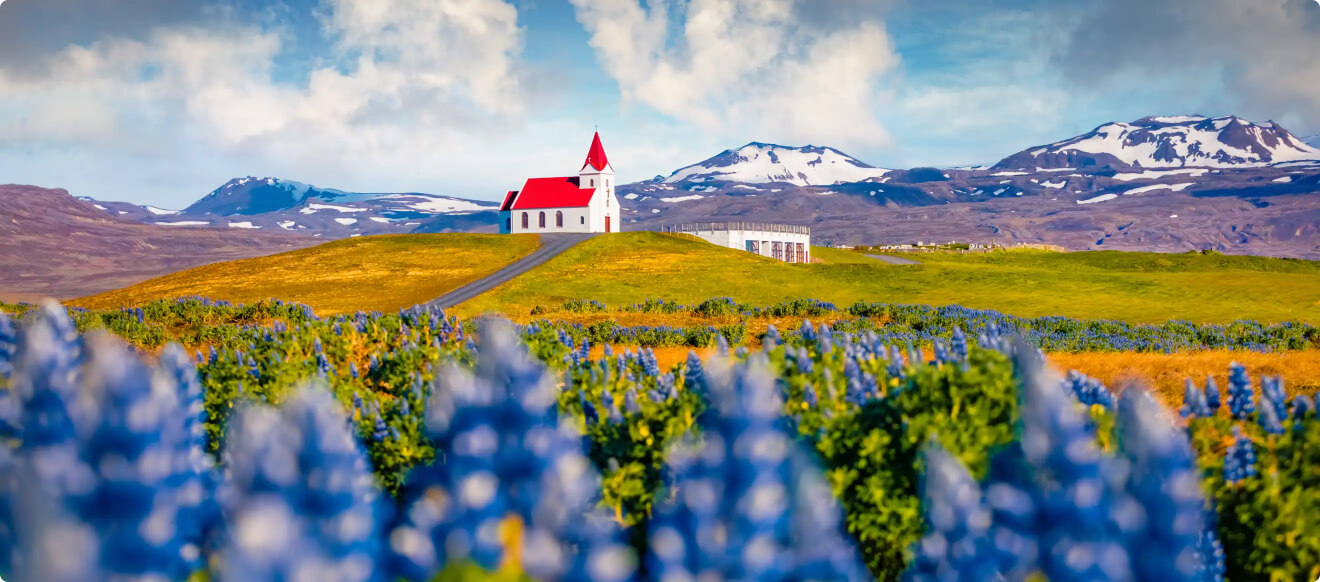Iceland is a land of geological wonders where you can find everything from therapeutic mud baths to violent volcanic eruptions. Hverir is something in between, with both toxic elements and mud filled with the most exotic compounds. Even if the mud here might not be something you’d like to have on your face, it offers a spectacle that will give you a memory of a lifetime.
If you want to visit odd things in Iceland, this is one of the best places to go. In this article, we tell you everything you need to know about Hverir. Hold on to your nose and enjoy reading!
What is Hverir?
Iceland has its fair share of locations that look like they are straight out of a fairytale or novel of mysticism. Some areas will remind you of beautiful getaways, while others will remind you of inhospitable planets. Hverir is part of the latter category.
Hverir in Iceland is part of the massive Námafjall Geothermal Area and offers a unique insight into the diverse nature of a volcanic landscape. The full name used to be “Hverir austan Námaskarðs”, which roughly translates to “Hot springs east of Námaskarð”. Námaskarð is the nearby mountain pass you drive through on the Ring Road.
There are two main types of attractions at Hverir: mud pools and fumaroles:
Mud Pools
The mud pools at Hverir are exactly what they sound like; large natural pools of boiling hot mud. They smell about as good as a month-old gym sock but look surprisingly pretty, considering their nature. Believe it or not, the mud pools at Hverir are the results of the cleanest spring- and rainwater. The only issue is that they boil underground and mix with sulfuric acid and minerals before reaching the surface, thus the smell.
Since Iceland is full of hot springs, one might think that these mud pools are ripe for a swim. Nothing could be further from the truth. The sludge can often reach over 80 degrees Celsius and sometimes even over 100 degrees, making it dangerous to get too close to. Some off-path parts of the ground can even reach an insane 200 degrees Celsius at times. Luckily, all paths at Hverir are clearly marked, so you won’t run the risk of getting a surprise mud bath.
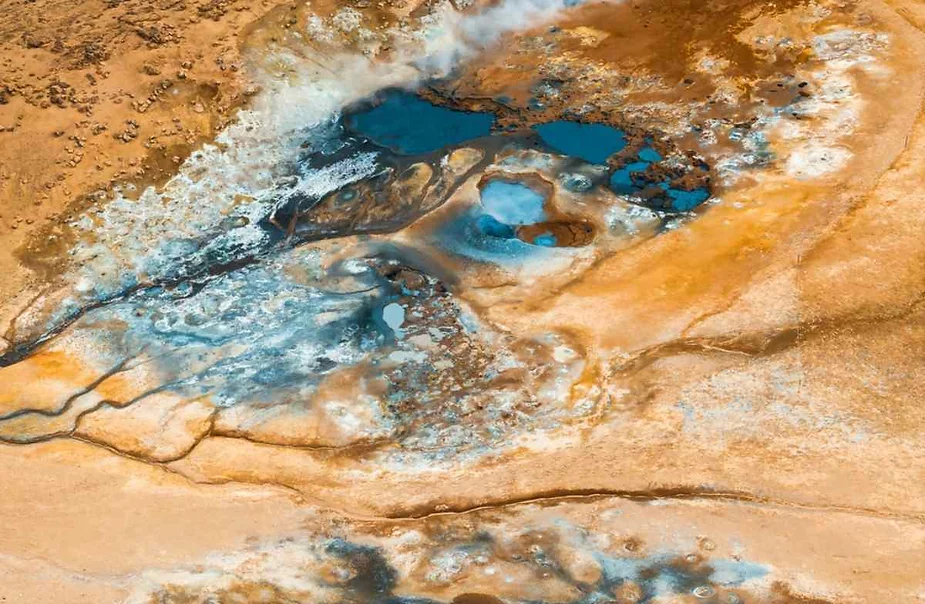
Fumaroles
If you wonder what a “fumarole” is, don’t feel left out. It’s not something most people come across in their everyday lives and not something you should know unless you are interested in geology or live around volcanic areas. Fumaroles can be seen as where volcanoes “exhale” without spewing out lava. The only things that come out are toxic fumes and stinky gas.
In the case of Hverir, these fumaroles often look like either large piles of colorful rocks or cracks in the ground. They’re easy to spot since they are as stinky as they come, even if they have mesmerizing colors.
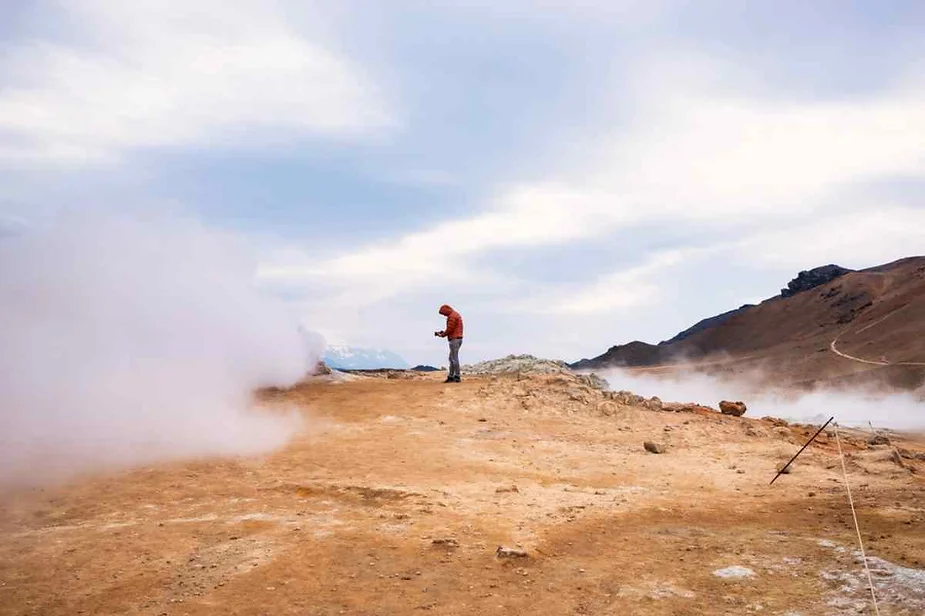
A Brief History of Hverir Geothermal Area
The Creation of Namafjall Hverir Geothermal Area is hard to put an exact time stamp on, but we know it has been active for at least 11,000 years. These types of geothermal areas often develop right before, during, in between, or after volcanic eruptions. Luckily, we’re not aware of any impending volcanic outbreaks in the area, so Hverir falls into the latest category.
Hverir has developed over a long period and has been molded through millennia of volcanic activity. During this time, many vents and mud pools have been created and collapsed, leaving different colored scars, cracks, and holes in the landscape.
A geothermal power plant was constructed in 1969 on the western side of the mountain pass (Hverir is on the eastern side). It’s currently producing roughly 3 MW of geothermal energy, and there are plans to increase production to 30 times the current output. Concerns have been raised regarding how it would affect the delicate ecosystem of the area, and construction hasn’t started yet.
Where is Hverir?
Hverir is located in Northern Iceland, close to the Mývatn area and almost directly connected to the Ring Road. It’s one of the most convenient places to stop if you’re driving the Ring Road and don’t have a lot of time to spare.
Measuring from Reykjavik, Hverir is roughly 475 kilometers away and will take almost 6 hours to reach if you don’t make any stops. From Akureyri (the capital of the north), you only have to drive for about 88 kilometers, which will take just over an hour.
How to Get to Hverir
Hverir is a popular destination in Northern Iceland, and you can reach it via guided tour or self-drive.
Drive Yourself to Hverir
Getting to Hverir from Reykjavik is easy, even if it takes a long time. All you have to do is drive the Ring Road, heading north, and continue for almost 6 hours straight until you’ve passed Reykjahlid and see the sign to Namafjall Geothermal Area.
Even though the trip from Reykjavik to Hverir can be made in a single swoop, we strongly suggest making this a multiple-day trip and stopping to see things like the Snaefellsnes Peninsula, The Museum of Witchcraft, and the whale-watching capital in Iceland: Húsavik.
Join a Tour
If you want to join a tour to Hverir, you’ll have to either join one of many day tours from Akureyri of the Mývatn Area or a multi-day tour of Iceland from Reykjavik. Most tours to Hverir will have it as one of the stops either along the Diamond Circle or as a part of a Mývatn sightseeing tour.
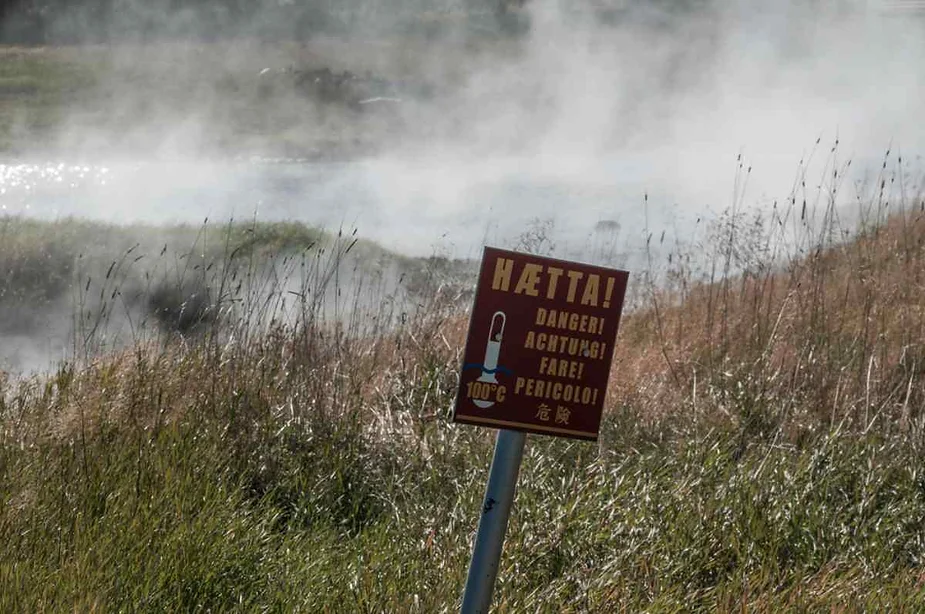
Visiting Hverir: What to Think of
There are a few basic things that are incredibly important to keep in mind when visiting Hverir:
- Keep within the marked routes and never step outside the boundaries. If you step outside, you might get really unlucky and step into something that is either hot enough to give you serious burns or acidic enough to give you chemical burns.
- Hverir is a field of ever-changing geothermal activity, so keep a respectable distance from the geothermal vents and bubbling mud pools. Splashes from the mud pools and a gush of wind in the wrong direction can make your visit a little unpleasant.
- This is not the place to go if you are sensitive to smells. The sulfuric fog is about as discreet as a baby’s diaper, not for the ones who are faint of nose.
To enhance your experience at Hverir, it's worth noting how the geothermal activity shifts between seasons. In summer, the landscape is a striking combination of vibrant, colorful earth and the thick steam rising from fumaroles and mud pots, offering amazing photo opportunities. However, in winter, the contrast between the snow-covered ground and the billowing steam clouds makes the geothermal features stand out even more dramatically. The steam often lingers longer in the crisp, cold air, creating an eerie, otherworldly atmosphere.
Apart from these simple things, Hverir is nothing short of magical. Maybe not Disney magic in terms of smell and looks, but it’s still magical! It’s like walking on another planet, and there are more things to photograph here than there are beers in a Viking Longhouse. The Hverir ticket price is zero since there is no entrance fee, so it will cost you nothing but time.
The magic of Hverir might get stuck in your clothes if you spend a lot of time here, so make sure to have clothes to change into after your visit. The clothes you explored the area with won’t complain if they get aired out when you arrive at your accommodation.
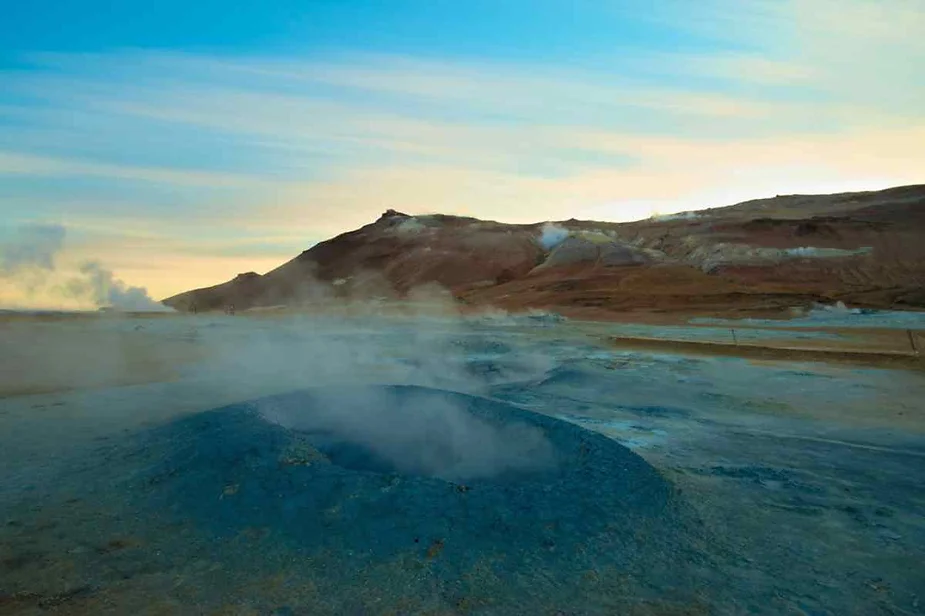
How Much Time to Spend at Hverir
If you love cool things like us, then you could spend an entire day at Hverir. You can follow the bubbling of the mud pools and observe the different colors coming from the fumaroles for hours.
If you’re not as fascinated by these things as we are, you can walk the pathway back and forth in less than an hour. Just ensure you get a couple of Hverir Photos along the way so you can enjoy the views without smelling eggs. For the photographers out there, the best times to capture the fumaroles' steam are during the early morning or late evening. These times offer softer, golden light, which creates stunning contrasts with the rising steam.
Things to Do Close to Hverir
Since Hverir is close to Mývatn, there are plenty of things to do and see in the vicinity. Below are some examples of places to visit and things to do close to Hverir:
- See the hot spring in a cave: Grotagja.
- Visit the waterfall of the gods: Godafoss.
- Walk in the Dimmuborgir Lava Field – a.k.a. the Black Fortress.
- Drive the Diamond Circle – a tour of Northern Iceland.
- Hike in the Asbyrgi Canyon – the imprint of a horse of the gods.
- Walk the rim of Hverfjall Volcano.
- See the Skútustadagigar Pseudocraters.
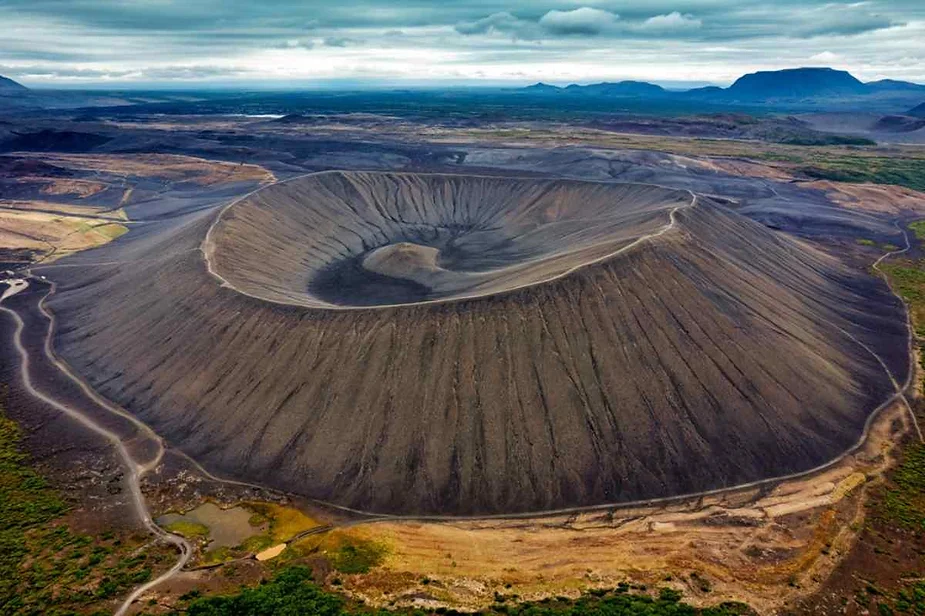
Where to Stay Close to Hverir
With all these things at the door, staying for a night or two near Hverir is almost a must. Below are some examples of nearby accommodation:
- Berjaya Iceland Hotels in Mývatn for a luxurious stay in a concept hotel.
- Fosshotel Mývatn is well-suited for those who want the classic hotel experience.
- Vogar Travel Service has a guesthouse, camping, and a pizzeria! Perfect budget option for a night or two.
- Mývatn Accommodation if you can’t decide. This place has a campsite, a guesthouse, apartments, cottages, a hostel, and a B&B.
Plan a Visit to Hverir
With all the things to do in Iceland, an egg-smelling visit might not be at the top of most people’s itineraries. We do, however, promise that Hverir is one of the few eggy places that are well worth a visit. The magnificent colors and impressive natural forces alone will make the visit worthwhile. But the bragging right of surviving the sulfuric smells is the cherry on top.
We are strong believers in being at the helm of our adventures, and there is no better way to achieve that than to take the wheel yourself. Rent a car in Iceland to get the most out of your holiday, and remember that even a smelly attraction can make life-long memories!









